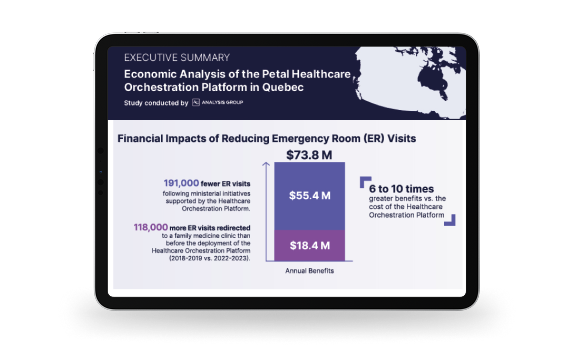Key takeaways
- The design of online and physical services impacts how patients feel long before, and long after, they receive care.
- Satisfied patients will become health teams best ambassadors. Collect their feedback, honour their communication preferences, and deploy their insights strategically.
- A centralized, health orchestration hub featuring integrated patient data provides invaluable visibility into department operations. Ensure teams function efficiently to provide optimal patient care.
A visit to a health care facility is first and foremost a human experience. Whether as a patient in a healthcare facility or as a customer in a retail store, people now expect the same standard of customer service quality. An improved patient experience is vital to a clinic or hospital’s standing in the community.
Healthcare managers play a key role in shaping patient management systems that deliver a seamless, personalized experience across the health ecosystem. This includes every step from appointment booking and follow-up interactions to time spent waiting for care.
Read on for strategic actions proven to increase patient satisfaction and long-term engagement with providers.
6 strategic actions to improve patients’ experience
- Build your improved patient experience before patients arrive
- Collect feedback to know your patients better
- Simplify travel
- Build relationships between professionals
- Always keep patients informed
- Support your staff experience too
1. Structure the experience before patients arrive
The relationship with your patients begins long before they set foot in your facility. What information can they find about you online? Is your website designed with accessibility in mind? Is your appointment booking information easily available?
Scheduling must be clear for successful patient management. Remember that not everyone who needs to use your services has the same preferences. For some, online appointment scheduling offers greater convenience. For others, a telephone service is the preferred method of communication.
- Tip: When deploying an online form, consider reducing the time required to respond by asking only for information that will be used later.
Further, the design of your facility will strongly influence patients’ and visitors’ experiences.[1] Healthcare managers should ensure on-site navigation, visitor amenities (such as breastfeeding stations and ample seating), and green spaces support positive feelings for patients and their families. The health ecosystem is digital and physical.
[1] Jamshidi, S., Parker, J. S., & Hashemi, S. (2020). The effects of environmental factors on the patient outcomes in hospital environments: A review of literature. Frontiers of Architectural Research, 9(2), 249–263. https://doi.org/10.1016/j.foar.2019.10.001
2. Collect feedback—and then use it
Understanding your patients is essential to improving their experience. While most healthcare settings collect feedback, it’s the strategic use of that input that drives meaningful change.
- Did you know healthcare professionals consistently report struggling to deploy their feedback findings given limited staff time and subject expertise?[1]
Surveys, online ratings, interviews, and direct conversations offer valuable insights, but staff often lack the time or expertise to act on them. Tools like the University of Toronto’s Patient Experience Survey provide a helpful starting point for building effective feedback programs.
Track key patient data whether it’s contact details, or demographics to improve operational efficiency. When changes are made based on feedback, communicate them clearly. Your most satisfied patients can become powerful ambassadors.
Once a patient engages with your facility, proactive communication becomes essential. Send appointment reminders, pre-visit instructions, and clear directions to help them feel prepared and supported.
[1] Gleeson, H., Calderon, A., Swami, V., & colleagues. (2016). Systematic review of approaches to using patient experience data for quality improvement in healthcare settings. BMJ Open, 6(8), e011907. https://doi.org/10.1136/bmjopen-2016-011907
[1] Jamshidi, S., Parker, J. S., & Hashemi, S. (2020). The effects of environmental factors on the patient outcomes in hospital environments: A review of literature. Frontiers of Architectural Research, 9(2), 249–263. https://doi.org/10.1016/j.foar.2019.10.001
[2] Gleeson, H., Calderon, A., Swami, V., & colleagues. (2016). Systematic review of approaches to using patient experience data for quality improvement in healthcare settings. BMJ Open, 6(8), e011907. https://doi.org/10.1136/bmjopen-2016-011907

3. Simplify travel
Getting around a health care facility can be hazardous for vulnerable patients, and especially so when facilities are large. Consider optimizing signage to make it easier to get around and train staff to communicate with lost visitors. Some innovative hospitals use wayfinding mobile apps to guide patients from parking lot selection to correct department identification.
Further, a positive relationship with municipal contacts facilitates an improved patient experience, such as through adjustments external to the healthcare setting. For example, if patients describe struggling to understand highway exit signs or local roadway directions on their way to receive care, then municipal administrators become valuable support in promptly relieving these challenges.
4. Nurture patient management relationships among professionals
Patients expect you to have a complete understanding of their situation, regardless of the departments they have visited. Your facility is a single entity in their eyes. Communication between clinicians and other staff becomes essential to get the whole picture of a patient’s journey within your facility (and beyond if possible). If there are links between departments, communication should be smooth, responsiveness more efficient, and patients should not need to repeat their story from one department to another.
5. Always keep patients informed
Again, communication is key to maintaining a good relationship with your patients. Once they are there, keep them informed. Is the schedule going as planned or will there be an additional wait time? In all circumstances, transparency is key. Patients will know what to expect, which tends to reduce patient dissatisfaction and impatience.
Patients expect more than receiving test results quickly. They also want to understand their situation more clearly and know the next steps for their treatment.
6. Support your staff’s experience too
Beyond an improved patient experience, it’s important to care about the experience of your employees. Your healthcare professionals perform better when they feel better.[1] They are the ones who embody the values and personality of your facility on a daily basis. They are your face (and your smile). They can make the difference for every patient who walks through your door. Never forget that happy employees make for happy patients!
The Petal Platform guides a better patient experience along the care journey
Petal solutions, including patient self-scheduling, clinical capacity management, and care coordination, improve operational efficiency and access to care by providing robust visibility into facilities’ operations. In turn, Petal users make more informed decisions and enjoy smoother cross-team collaboration. These outcomes allow better coordination of hospital staff and patient care throughout the patient journey.
Patient management across health ecosystems will run more smoothly when we make strategic decisions today.
Discover how Petal supports rapid staff communications and simpler patient care:
- [1] Murden, F., Bailey, D., Mackenzie, F., Oeppen, R. S., & Brennan, P. A. (2018). The impact and effect of emotional resilience on performance: An overview for surgeons and other healthcare professionals. British Journal of Oral and Maxillofacial Surgery, 56(9), 786–790. https://doi.org/10.1016/j.bjoms.2018.08.012
- Jamshidi, S., Parker, J. S., & Hashemi, S. (2020). The effects of environmental factors on the patient outcomes in hospital environments: A review of literature. Frontiers of Architectural Research, 9(2), 249–263. https://doi.org/10.1016/j.foar.2019.10.001
- Gleeson, H., Calderon, A., Swami, V., & colleagues. (2016). Systematic review of approaches to using patient experience data for quality improvement in healthcare settings. BMJ Open, 6(8), e011907. https://doi.org/10.1136/bmjopen-2016-011907
- Murden, F., Bailey, D., Mackenzie, F., Oeppen, R. S., & Brennan, P. A. (2018). The impact and effect of emotional resilience on performance: An overview for surgeons and other healthcare professionals. British Journal of Oral and Maxillofacial Surgery, 56(9), 786–790. https://doi.org/10.1016/j.bjoms.2018.08.012

![PT_VOMBSFP_202509_EN[1]](https://www.petal-health.com/wp-content/uploads/2025/10/PT_VOMBSFP_202509_EN1.png)
![Rapport économiquepouce-non-arrière-plan(1)[1]](https://www.petal-health.com/wp-content/uploads/2025/10/Economic20report20thumb-no20background2011-768x548.png)